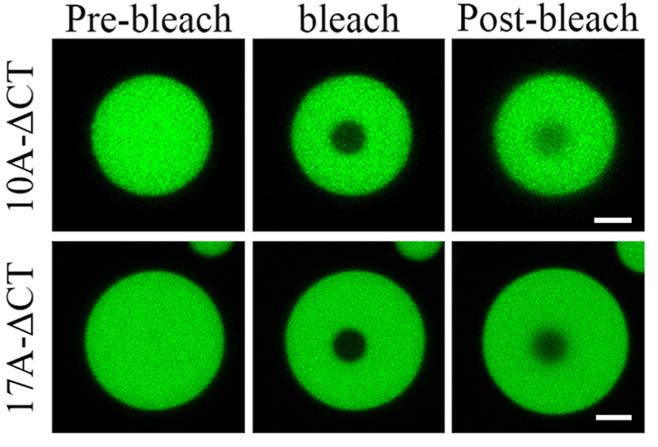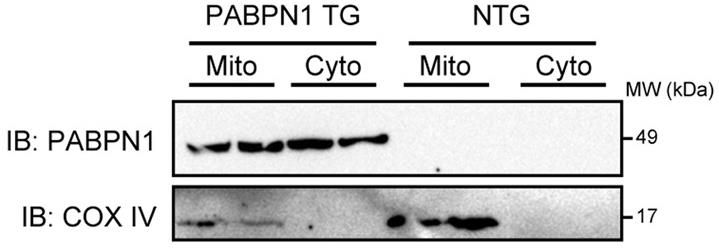PABPN1
-
Official Full Name
poly(A) binding protein, nuclear 1 -
Overview
This gene encodes an abundant nuclear protein that binds with high affinity to nascent poly(A) tails. The protein is required for progressive and efficient polymerization of poly(A) tails at the 3 ends of eukaryotic transcripts and controls the size of the poly(A) tail to about 250 nt. At steady-state, this protein is localized in the nucleus whereas a different poly(A) binding protein is localized in the cytoplasm. This gene contains a GCG trinucleotide repeat at the 5 end of the coding region, and expansion of this repeat from the normal 6 copies to 8-13 copies leads to autosomal dominant oculopharyngeal muscular dystrophy (OPMD) disease. Related pseudogenes have been identified on chromosomes 19 and X. Read-through transcription also exists between this gene and the neighboring upstream BCL2-like 2 (BCL2L2) gene. -
Synonyms
PABPN1;poly(A) binding protein, nuclear 1;OPMD, PABP2, poly(A) binding protein, nuclear 1;polyadenylate-binding protein 2;PAB2;Nuclear poly(A) binding protein 1;PABII;PABP2;Poly(A) binding protein 2;Polyadenylate binding nuclear protein 1;Polyadenylate binding protein 2;ROX2;OTTHUMP00000164595;OTTHUMP00000164596;OTTHUMP00000246235;OTTHUMP00000246236;poly(A) binding protein II;OPMD;PABP-2
Recombinant Proteins
- Human
- Mouse
- Zebrafish
- HEK293
- Mammalian Cell
- E.coli
- Insect Cells
- His
- Non
- His&Fc&Avi
Background
What is PABPN1 Protein?
PABPN1 is an RNA-binding protein with a key role in the cell nucleus. It essentially manages the length of the poly(A) tail on mRNA, crucial for how mRNA is processed, moved, renewed, and broken down. By linking up with the poly(A) tail of new mRNA, PABPN1 switches on polyadenylate polymerase (PAP) to aid mRNA polyadenylation. Plus, it’s part of the action in alternative splicing and getting mRNA out of the nucleus. PABPN1 is located in nuclear speckles, where it aids in controlling poly(A) tail synthesis. The protein’s N-terminal has a repeat sequence of 10 alanines, which can expand in certain genetic disorders, resulting in nuclear aggregates, like in oculopharyngeal muscular dystrophy (OPMD). Understanding PABPN1’s aggregation and its role in diseases is a key research focus. Thus, PABPN1 is essential in post-transcriptional RNA processing and is linked to some muscle degenerative conditions.What is the Function of PABPN1 Protein?
PABPN1 is an RNA-binding protein hanging out in the cell nucleus, crucial for all sorts of RNA metabolism tasks. It links up with the poly(A) tail on fresh mRNA to step up the activity of polyadenylate polymerase, boosting mRNA polyadenylation. Besides that, it gets involved in alternative splicing and helps mRNA exit the nucleus. PABPN1’s connection with the poly(A) tail also plays a part in controlling how mRNA translates and stays stable, impacting its processing, movement, refreshing, and breakdown. Plus, PABPN1’s got a hand in regulating long non-coding RNA levels by affecting their stability through degradation. Even in the cytoplasm, it’s part of the cap-binding complex and associated with ribosomes, essential for keeping mRNA in check. PABPN1’s role isn’t just limited to the nucleus—it can do its thing in the cytoplasm too, like mRNA cytoplasmic deadenylation seen in flies. So, it’s key in the post-transcriptional handling of RNA and mRNA metabolism both in the nucleus and cytoplasm.
Fig1. PABPN1 phosphorylation prevents hyperadenylation and maintains RNA dynamics. (Jackson M Gordon, 2024)
PABPN1 Related Signaling Pathway
PABPN1 has a hand in several signaling pathways, especially in RNA metabolism and regulation. Inside the nucleus, it binds to the poly(A) tails of new mRNA to kickstart PAP, boosting mRNA polyadenylation. It also plays a part in selective polyadenylation by binding to weak proximal cleavage sites so polyadenylation happens at stronger distal ones. PABPN1 helps with getting mRNA out of the nucleus, and in the cytoplasm, it takes part in the first round of translation, which is crucial for mRNA quality control. It’s initially associated with the nuclear cap-binding complex but later gets replaced by cytoplasmic PABPC1. PABPN1 might also be involved in cytoplasmic deadenylation. In some species, it deals with the processing of snRNAs and the breakdown of meiotic transcripts. Additionally, it connects with pathways like Wnt, cell cycle, and lipid biosynthesis, impacting bladder cancer progression. So, PABPN1 is a key player in gene expression regulation, mRNA stability and translation, and even tumor growth pathways.PABPN1 Related Diseases
PABPN1 protein is linked to several diseases, especially autosomal dominant oculopharyngeal muscular dystrophy (OPMD). OPMD shows up later in life, slowly worsening with symptoms like droopy eyelids, trouble swallowing, and weak arms and legs. It’s caused by an unusual expansion of GCG trinucleotide repeats in the PABPN1 gene, leading to misfolding of PABPN1 and forming aggregates in the nucleus, a hallmark of OPMD. Besides OPMD, PABPN1’s abnormal clumping or mutations tie to other genetic disorders like muscle wasting and specific muscular dystrophies. A loss of PABPN1 function may disrupt muscle protein balance and cellular processes related to protein homeostasis, ubiquitin-proteasome system, and translation. PABPN1 might also play a role in colorectal cancer progression by shortening the 3’ UTR of CTNNIBP1, boosting cell growth and movement. In kidney cancer, its impact on sphingolipid metabolism and cell cycle suggests it might encourage cancer cell growth, making PABPN1 a vital target for disease research and therapy in both neuromuscular disorders and certain cancers.Bioapplications of PABPN1
Recombinant PABPN1 protein finds various applications in research, industry, and medicine. In research, PABPN1 is crucial for regulating the poly(A) tail length of mRNA, influencing mRNA decay, splicing variants, and post-transcriptional processing during early embryo development. These studies help us understand mRNA metabolism and embryonic development mechanisms. Industrial applications of PABPN1 drive the creation of bio-products and drugs, especially related to genetic disorders and reproductive health. Medically, PABPN1 is linked to diseases like oculopharyngeal muscular dystrophy (OPMD) and certain cancers, where its abnormal aggregation and loss of function can lead to muscle atrophy, while expression changes may affect tumor growth and spread. Thus, recombinant PABPN1 is vital for researching disease mechanisms, validating drug targets, and developing new therapies.Case Study
Case Study 1: Guan WL. et al. J Biol Chem. 2023
PABPN1 is an RNA-binding protein found in nuclear speckles, but when its alanine (Ala) is expanded, it forms intranuclear aggregates in oculopharyngeal muscular dystrophy. The reasons behind this aggregation and its effects are not well understood. Our study looked into how the Ala stretch and poly(A) RNA affect PABPN1 using various methods. We found that the Ala stretch influences its movement within nuclear speckles, and its expansion causes aggregation. Poly(A) RNA is crucial for forming and transitioning speckles into more solid aggregates. These aggregates can trap CFIm25, part of the pre-mRNA 3’-UTR processing complex, in a way that’s dependent on mRNA, affecting CFIm25’s role in alternative polyadenylation.-
 Fig1. S/P fractionation for Ala-expanded variants of PABPN1.
Fig1. S/P fractionation for Ala-expanded variants of PABPN1. -
 Fig2. FRAP analysis of the EGFP-tagged PABPN1-10A-ΔCT and 17A-ΔCT variants in vitro.
Fig2. FRAP analysis of the EGFP-tagged PABPN1-10A-ΔCT and 17A-ΔCT variants in vitro.
Case Study 2: Doki T. et al. Lab Invest. 2019
Oculopharyngeal muscular dystrophy (OPMD) shows up later in life with eyelid drooping, trouble swallowing, and weakening of muscles near the torso. It’s largely due to an increase in polyalanine in the PABPN1 protein. Though there’s talk about mitochondria being part of the problem, the details are foggy. Researchers used a mouse model with the expanded PABPN1 to see if it really messes with mitochondria, contributing to muscle breakdown. They found PABPN1 in the mitochondria of OPMD patients and noticed it building up in the mitochondria’s inner membrane in mice, cutting down on proteins needed for energy production. In cells, both short and long stretches of alanine in PABPN1 stuck to mitochondria, but the longer ones led to more cell trouble. It’s suspected that this buildup might be key to mitochondrial issues in OPMD.-
 Fig3. Immunoblots for PABPN1 and COX IV using the cytosolic (cyto) and mitochondria (mito) fractions of the 40-week-old TG and NTG mice.
Fig3. Immunoblots for PABPN1 and COX IV using the cytosolic (cyto) and mitochondria (mito) fractions of the 40-week-old TG and NTG mice. -
 Fig4. Immunoblots for PABPN1 and VDAC using the cytosolic and mitochondria fractions of cells transfected with EGFP, EGFP-A10, or EGFP-A18.
Fig4. Immunoblots for PABPN1 and VDAC using the cytosolic and mitochondria fractions of cells transfected with EGFP, EGFP-A10, or EGFP-A18.
Quality Guarantee
High Purity
-
.jpg) Fig1. SDS-PAGE (PABPN1-01H)
Fig1. SDS-PAGE (PABPN1-01H)
-
.jpg) Fig2. SDS-PAGE (PABPN1-3928H)
Fig2. SDS-PAGE (PABPN1-3928H)
Involved Pathway
PABPN1 involved in several pathways and played different roles in them. We selected most pathways PABPN1 participated on our site, such as mRNA surveillance pathway,Influenza A, which may be useful for your reference. Also, other proteins which involved in the same pathway with PABPN1 were listed below. Creative BioMart supplied nearly all the proteins listed, you can search them on our site.
| Pathway Name | Pathway Related Protein |
|---|---|
| mRNA surveillance pathway | SSU72,CPSF6,MAGOHB,NXT1,PPP2CA,NXT2,CSTF2T,PPP2CB,PPP2R2B,NCBP1 |
| Influenza A | IFN-a,HSPA1L,MAP2K7,NXT2,HSPA2,NUP98,PRKCA,MX1,MAPK11,TNFRSF10D |
-
 Fig1. Domain structure of bovine PABPN1. (Elmar Wahle, 2013)
Fig1. Domain structure of bovine PABPN1. (Elmar Wahle, 2013) -
 Fig2. Only the co-injection of the two vectors inhibits the aggregate formation while rescuing the normal PABPN1 to the level vital for optimal cell survival and functionality in A17 muscles. (A Malerba, 2017)
Fig2. Only the co-injection of the two vectors inhibits the aggregate formation while rescuing the normal PABPN1 to the level vital for optimal cell survival and functionality in A17 muscles. (A Malerba, 2017)
Protein Function
PABPN1 has several biochemical functions, for example, RNA binding,nucleic acid binding,nucleotide binding. Some of the functions are cooperated with other proteins, some of the functions could acted by PABPN1 itself. We selected most functions PABPN1 had, and list some proteins which have the same functions with PABPN1. You can find most of the proteins on our site.
| Function | Related Protein |
|---|---|
| poly(A) RNA binding | MAGOH2,UBE2I,PTBP1,EIF5A,RBFOX2,ZFP207,PATL1,SF1,TOP3B,CEBPZ |
| RNA binding | BICC1,DUSP11,MRPL12,PSMA1,THUMPD2,KIAA0430,RBM23,AGFG1,RPL30,CPEB1B |
| nucleic acid binding | ZNF219,TTC14,VEZF1B,KLF12A,PRKRIRA,POLR2GL,ZNF438,DDX19,DHX57,NABP2 |
| nucleotide binding | GM7168,SNRKB,PKM,DQX1,IIGP1,DCLK1A,GNA12A,STK38A,RBM34,GBP3 |
| poly(A) binding | RBPMS,PABPC4,DDX3X,PABPC1,ZC3H14,HNRNPDL,PABPC3,KHDRBS2,PAIP2B,HNRPDL |
| protein self-association | ZFP639,MALT1,DVL2,AGTR1A,SHANK3,SVIP,BCL10,LDB1,ADAM8,TRP53 |
Interacting Protein
PABPN1 has direct interactions with proteins and molecules. Those interactions were detected by several methods such as yeast two hybrid, co-IP, pull-down and so on. We selected proteins and molecules interacted with PABPN1 here. Most of them are supplied by our site. Hope this information will be useful for your research of PABPN1.
Mylk;Ywhae
Resources
Related Services
Related Products
References
- Impagliazzo, A; Tepper, AW; et al. Structural basis for a PABPN1 aggregation-preventing antibody fragment in OPMD. FEBS LETTERS 584:1558-1564(2010).
- Hahn, S; Nesslinger, NJ; et al. Castration induces autoantibody and T cell responses that correlate with inferior outcomes in an androgen-dependent murine tumor model. INTERNATIONAL JOURNAL OF CANCER 125:2871-2878(2009).


